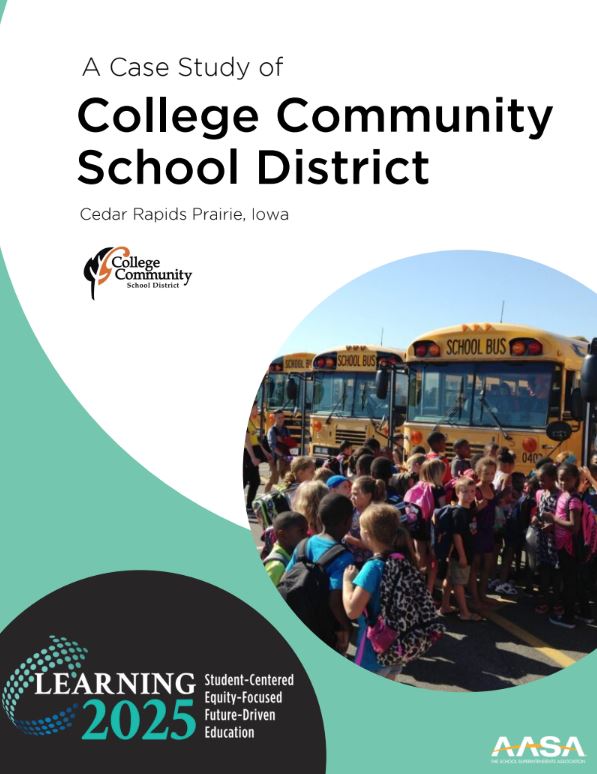Case Study: College Community School District (Iowa)
July 24, 2023
How one AASA Learning 2025 Demonstration System is Optimizing It's Use of Data-Driven Assessment and Evaluation Processes
AASA Learning 2025 Demonstration Systems are creating student-centered, equity-focused, and future-driven educational systems that serve ALL learners.

The College Community School District is deeply committed to using data-driven assessment and evaluation processes to monitor student progress and determine the impact of its instructional and support programs. Specifically, the district identifies the following key evidence to be used to determine growth in identified Learning 2025 redesign components:
- District-wide Common Assessments (DCAs) are given throughout the year in English and Mathematics. During the 2022-23 academic year, the district is beginning a process to add Social Studies and Science in Grade 9-12. The goal is to measure effectiveness of Tier 1 (i.e., the comprehensive curriculum and instructional program for all learners) programs and practices, targeting 80% proficient at first attempt as a key “look-for” indicator.
- Stakeholder Surveys: A range of surveys will be used to determine growth in a range of identified areas, including a strong emphasis upon social and emotional learning indicators:
- Student Key Indicators: Belonging and Equity; Learning Engagement; and Future-Ready/Career Preparation
- Staff Indicators: Belonging and Equity; Personalized Learning Actions; Professional Learning Communities; and SEBH Themes
- Parents/Families Indicators: Belong and Equity;
- Standardized Growth Assessments: CCSD is committed to using standardized test and related data to monitor the impact and value-added effects of its 10-year strategic planning process, including
- Iowa Statewide Assessment of Student Progress (ISASSP): English Language Arts (Grades 3–11); Mathematics (Grades 3–11); and Science (Grades 5, 8, 10)
- Elementary Progress Monitoring: FAST Literacy (Grades K-6) and iReady Math (Grades K-6)
- Middle Level Progress Monitoring: NWEA MAP Growth (Grades 7-9)
- High School: ACT Data, Grade 11
- SEBH Data (Growth):
- Early Indicator Reports: Attendance (Overall and Chronic Absenteeism); Behavior; Universal Screening, K–6 (Social Academic Behavior Risk Screener); Academic Progress
- Equity Reports: Academic and Behavior (i.e., Major/Serious Behavior and/or Suspension); Instructional Practice: Implementation of Phonics and Comprehension Best Practices (K–6); Implementation of Effective Mathematics Teaching Practices (K–6); and Teacher Growth on the Core Teaching Capabilities (PK–12)
This case study demonstrates how the College Community School District is optimizing it's use of data-driven assessment and evaluation processes to create personalized learning systems for all.
Quick District Facts:
District Enrollment: 5,700 students
District Demographics: The district's area of service is 136 square miles including rural, suburban and urban areas. The district serves an increasingly diverse population of students, including:
- 20% non-White
- 13% Special Education
- 8.5% Gifted and Talented
- 4% English Language Learners
- 33% qualify for Free and Reduced Lunch
CCSD's graduation rate is consistently 93% or higher with over 60% of students earning college credit before graduation and over 85% of students participating in an extra or co-curricular activity.
Advertisement
Advertisement
Advertisement
Advertisement

-(9).png?sfvrsn=36febad1_7)

